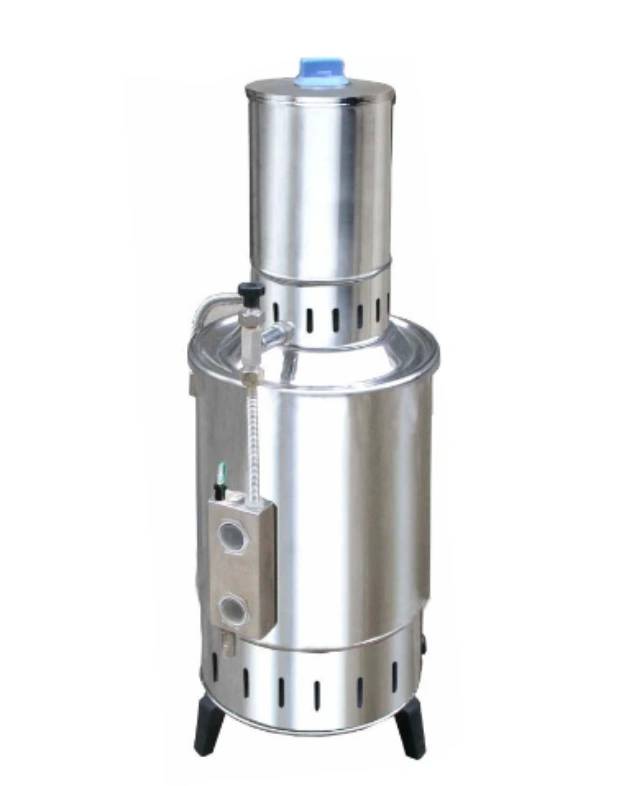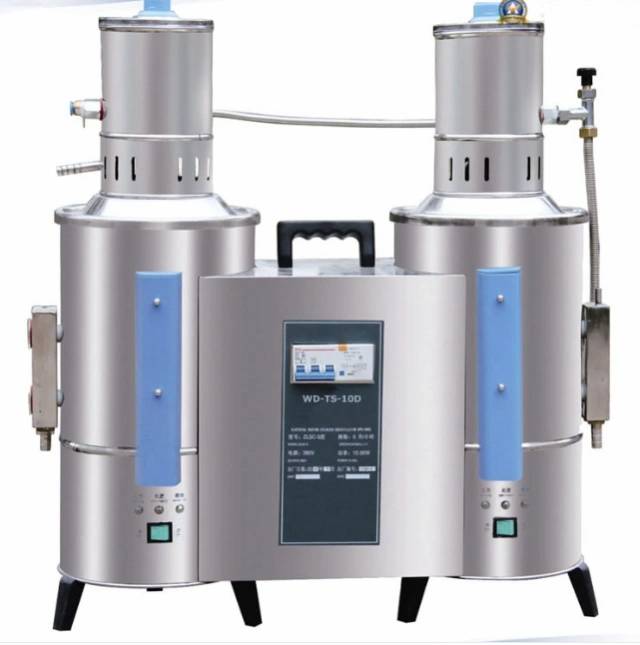
sterilization equipment
Wall Mounted Water Distillation Unit
Item Number : KT-C01
Price varies based on specs and customizations
- pH Value
- 5~6
- Capacity of Pan
- 5.5 Liter
- Electric Tension
- AC 220V~240V / 50Hz~60Hz
Shipping:
Contact us to get shipping details Enjoy On-time Dispatch Guarantee.
Why Choose Us
Easy ordering process, quality products, and dedicated support for your business success.
Operation
The raw water enters the bottom end of the condensing pipe, circulates along the condensing and cooling pipe, and finally enters the evaporating pot. The height of the water in the evaporating pot is preset by the overflow dam. The descending steam in the condensing tube preheats the rising raw water in the column, which is more economical and allows the discharged liquid to dissolve in it. Stills are designed so that vent gases can be vented into the atmosphere.
The steam generated in the evaporator passes through the deflector device to the condenser. The baffles are installed so that the steam changes direction three times before entering the condenser. In this way it is possible to prevent entrainment of raw water which is the main cause of chemical or organic softening (degradation) in distilled water. If it works properly, you can get water without heat source. The evaporator, condenser, overflow dam and internal baffles are all made of stainless steel. Both the external cover and the cap of the internal deflector are made of high temperature resistant borosilicate glass, and all electrical components are installed with protective
Detail & Parts


Technical Parameters
| Model | KT-3.5~4.5L/h |
| Power supply | AC220V~240V/50Hz -60Hz |
| Water output | 3.5-4.5L/h |
| Power | 1.5Kw x2 |
| Net weight | 7kg/set |
| Gross weight | 8kg/set |
| Box size | 740x400x140mm/set |
| Evaporator volume | 5.5liter |
| PH value | 5-6 |
Designed for You
KinTek provide deep custom made service and equipment to worldwide customers, our specialized teamwork and rich experienced engineers are capable to undertake the custom tailoring hardware and software equipment requirements, and help our customer to build up the exclusive and personalized equipment and solution!
Would you please drop your ideas to us, our engineers are ready for you now!
4.8 / 5
This distillation unit is a lifesaver in our lab. It's fast, efficient, and produces high-quality water.
4.9 / 5
I've been using this unit for a few months now and I'm very happy with it. It's easy to use, clean, and maintain.
4.7 / 5
This is the best distillation unit I've ever used. It's durable, reliable, and produces consistent results.
4.8 / 5
I highly recommend this unit to anyone who needs a reliable and efficient way to produce high-quality water.
4.9 / 5
This unit is a great value for the money. It's well-made and performs as well as units that cost twice as much.
4.7 / 5
I'm very impressed with the quality of the water produced by this unit. It's crystal clear and tastes great.
4.8 / 5
This unit is very easy to use. I was able to set it up and start using it in just a few minutes.
4.9 / 5
I'm very happy with the customer service I received from KINTEK SOLUTION. They were very helpful and responsive to my questions.
4.7 / 5
Overall, I'm very happy with this distillation unit. It's a great value for the money and I would definitely recommend it to others.
REQUEST A QUOTE
Our professional team will reply to you within one business day. Please feel free to contact us!
Related Products

Multifunctional Electrolytic Electrochemical Cell Water Bath Single Layer Double Layer
Discover our high-quality Multifunctional Electrolytic Cell Water Baths. Choose from single or double-layer options with superior corrosion resistance. Available in 30ml to 1000ml sizes.
Related Articles

Step-by-Step Guide to Operating a Short Path Distillation Apparatus
Operating of Short Path Distillation and Precautions

How Rotary Evaporators are Revolutionizing Distillation
Rotary evaporators, also commonly referred to as rotovaps, are laboratory equipment used for the separation of solvents from a mixture through the process of distillation.

The Importance of Water Distillation in the Laboratory: Ensuring Purity and Quality for Accurate Results
Water distillation is an important process in the laboratory, as it ensures the purity and quality of the water being used in experiments and testing procedures.

How Rotary Evaporator Can Improve the Quality of Your Distillate
A rotary evaporator is a laboratory equipment used for distillation and solvent recovery processes. It works by rotating the flask containing the mixture under vacuum, which allows for efficient separation of the components based on their boiling points.

How Rotary Evaporator is Different from Conventional Distillation
Rotary evaporator and conventional distillation are two widely used methods for separating mixtures. While both techniques aim to achieve the same end goal, they differ significantly in their principles and efficiency.

What Is Multiple Effect Evaporator?
A multiple-effect evaporator, as defined in chemical engineering, is an apparatus for efficiently using the heat from steam to evaporate water.

Understanding the Science Behind Short Path Distillation
Short path distillation is a precise and efficient method of separating and purifying liquids through a process of distillation.

What Is Boiling Point Rise In Evaporators?
The evaporators produce concentrated solution having substantially higher boiling point than that of the solvent (of the solution) at the prevailing pressure.

Comparing the Features of Laboratory Waterbaths: A Guide to Finding the Right Waterbath for Your Needs
Water bath is a common piece of laboratory equipment that is used to heat samples or substances to a specific temperature.

Why Tap Water Chilling Is Not Enough for Your Rotavap
Proper chilling is crucial for many laboratory applications, including rotavap. Without proper cooling, the solvent vapor produced during the rotavap process may condense in the wrong place and affect the quality of the final product.

Welcome Our Canada Customers Visit Kindle Tech Group
Welcome our Canada customers visit Kindle Tech Group, customer satisfied with the workshop which strictly control the quality, technical team introduced all the procedure of the production.

WIP – Warm Isostatic Press Equipment: Design, Features, and Benefits
KinTek specializes in designing and building Warm Isostatic Presses (WIP) for various applications. These systems can be either gas or liquid pressurized and are commonly used for plastics and laminated products. WIPs are custom-built to accommodate different pressure levels, ranging from low pressure to extreme pressures.